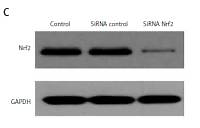Current issue
Archive
Manuscripts accepted
About the Journal
Editorial office
Editorial board
Section Editors
Abstracting and indexing
Subscription
Contact
Ethical standards and procedures
Most read articles
Instructions for authors
Article Processing Charge (APC)
Regulations of paying article processing charge (APC)
ORTHOPEDICS AND TRAUMATOLOGY / EXPERIMENTAL RESEARCH
Lycium barbarum polysaccharides exert an antioxidative effect on rat chondrocytes by activating the nuclear factor (erythroid-derived 2)-like 2 signaling pathway
1
Department of Orthopedics, Zhejiang Provincial People’s Hospital, People’s Hospital of Hangzhou Medical College, Hangzhou, China
2
Department of Hand Surgery and Reconstruction Surgery, Zhejiang Provincial People’s Hospital, People’s Hospital of Hangzhou Medical College, Hangzhou, China
3
Department of Orthopedics, The Fifth People’s Hospital of Yuhang District, Hangzhou, China
Submission date: 2017-05-23
Final revision date: 2017-08-24
Acceptance date: 2017-08-28
Online publication date: 2018-07-10
Publication date: 2020-05-26
Arch Med Sci 2020;16(4):964-973
KEYWORDS
osteoarthritisantioxidantLycium barbarum polysaccharidesnuclear factor (erythroid-derived 2)-like 2 (Nrf2)
TOPICS
ABSTRACT
Introduction:
Oxidative stress is the main cause of osteoarthritis (OA). Lycium barbarum polysaccharides (LBP) have antioxidant properties. Thus, the potential effect of LBP on H2O2-stimulated chondrocytes was examined.
Material and methods:
The cell viability was detected by CCK-8. The reactive oxygen species (ROS) production and apoptosis rates were determined by flow cytometric analysis. The DNA damage was detected by comet assay. Real-time polymerase chain reaction (qPCR) and Western blot assays were performed to examine the expression of histone 2A family member X (H2AX), checkpoint kinase 1 (Chk1), poly ADP-ribose polymerase (PARP), cysteinyl aspartate specific proteinase (caspase)-3/8/9, and nuclear factor (erythroid-derived 2)-like 2 (Nrf2) and its antioxidant-response element (ARE) dependent factors including heme oxygenase-1 (HO-1) and quinine oxidoreductase-1 (NQO-1).
Results:
Compared to the H2O2 group, LBP inhibited the ROS production and DNA damage caused by H2O2 (p < 0.05), respectively. LBP inhibited the mRNA and protein expressions of H2AX and Chk1 (p < 0.05). Meanwhile, LBP significantly decreased apoptosis (p < 0.05). And LBP inhibited the expression levels of PARP and Caspase-3/8/9 (p < 0.05). Moreover, LBP increased the expression of Nrf2, HO-1and NQO-1 (p < 0.05). Furthermore, the depletion of Nrf2 that mediated by RNA interference reversed the apoptosis and DNA damage inhibition effect of LBP (p < 0.05).
Conclusions:
LBP protected chondrocytes through inhibiting DNA damage and apoptosis caused by H2O2, in which the Nrf2/ARE signaling pathway played a positive role. It provided an inspiration for clinical application – developing LBP as a therapeutic agent and Nrf2 as a promising candidate.
Oxidative stress is the main cause of osteoarthritis (OA). Lycium barbarum polysaccharides (LBP) have antioxidant properties. Thus, the potential effect of LBP on H2O2-stimulated chondrocytes was examined.
Material and methods:
The cell viability was detected by CCK-8. The reactive oxygen species (ROS) production and apoptosis rates were determined by flow cytometric analysis. The DNA damage was detected by comet assay. Real-time polymerase chain reaction (qPCR) and Western blot assays were performed to examine the expression of histone 2A family member X (H2AX), checkpoint kinase 1 (Chk1), poly ADP-ribose polymerase (PARP), cysteinyl aspartate specific proteinase (caspase)-3/8/9, and nuclear factor (erythroid-derived 2)-like 2 (Nrf2) and its antioxidant-response element (ARE) dependent factors including heme oxygenase-1 (HO-1) and quinine oxidoreductase-1 (NQO-1).
Results:
Compared to the H2O2 group, LBP inhibited the ROS production and DNA damage caused by H2O2 (p < 0.05), respectively. LBP inhibited the mRNA and protein expressions of H2AX and Chk1 (p < 0.05). Meanwhile, LBP significantly decreased apoptosis (p < 0.05). And LBP inhibited the expression levels of PARP and Caspase-3/8/9 (p < 0.05). Moreover, LBP increased the expression of Nrf2, HO-1and NQO-1 (p < 0.05). Furthermore, the depletion of Nrf2 that mediated by RNA interference reversed the apoptosis and DNA damage inhibition effect of LBP (p < 0.05).
Conclusions:
LBP protected chondrocytes through inhibiting DNA damage and apoptosis caused by H2O2, in which the Nrf2/ARE signaling pathway played a positive role. It provided an inspiration for clinical application – developing LBP as a therapeutic agent and Nrf2 as a promising candidate.
Share
RELATED ARTICLE
We process personal data collected when visiting the website. The function of obtaining information about users and their behavior is carried out by voluntarily entered information in forms and saving cookies in end devices. Data, including cookies, are used to provide services, improve the user experience and to analyze the traffic in accordance with the Privacy policy. Data are also collected and processed by Google Analytics tool (more).
You can change cookies settings in your browser. Restricted use of cookies in the browser configuration may affect some functionalities of the website.
You can change cookies settings in your browser. Restricted use of cookies in the browser configuration may affect some functionalities of the website.



